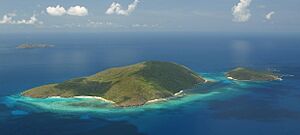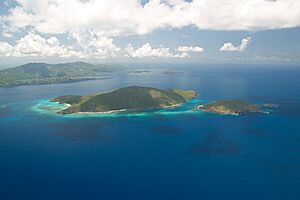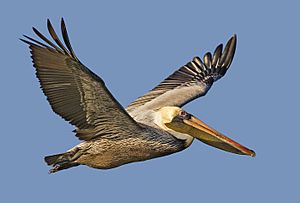Hans Lollik Island facts for kids
The Hans Lollik Islands are two islands in the U.S. Virgin Islands. They are owned by private groups. Great Hans Lollik Island (often called GHL) is about 2.5 kilometers (1.5 miles) north of St. Thomas. A water channel called the Leeward Passage separates them. Little Hans Lollik and Pelican Cay are also nearby, just north of Hans Lollik. The seafloor around Hans Lollik is mostly rocky. It has many different kinds of coral living there.
The name of the islands, "Hans Lollik," comes from the Danish words for "Hans from Lolland." People believe the islands were named after a sailor who had this nickname.
Contents
Island Features and Environment
The look of the Hans Lollik islands depends on their natural shape and how much wind they get. It also depends on how humans have used the land. Great Hans Lollik Island is not very high. It gets about 1,120 millimeters (44 inches) of rain each year. The east and northeast sides of the island often feel strong winds called trade winds.
The hillsides and valleys on the side away from the wind stay wetter. Different kinds of plants grow there compared to the windy slopes.
How Humans Changed the Islands
People living on the islands have greatly changed the environment. From the early 1700s to the mid-1800s, the Virgin Islands were cleared of trees and used for farming. Experts believe that about 12 to 16 hectares (30 to 40 acres) of Great Hans Lollik were used to grow cotton during this time.
Because the island is steep, the soil would wash into the sea when it rained. Some people think that several feet of topsoil were lost. In the 1940s and 1950s, trees on Great Hans Lollik were cut down for timber. This timber was sold in St. Croix. In the past, goats lived on the island. Today, only donkeys and rabbits remain.
Modern human activity has made Hans Lollik different from how it was before Europeans arrived. Clearing land, burning, and logging have changed the plants. Seeds for some plants that used to be there are now gone. Fires allowed tough plants like thatch palm to grow widely. Logging left behind mostly softwood trees like blolly and Geiger tree. People also brought new plants to the island. Some of these new plants have spread and now grow everywhere.
Animal Life on the Islands
No native land mammals live on Great Hans Lollik or Little Hans Lollik. The black rat was brought by early European settlers about 500 years ago. European rabbits, cats, and donkeys were also brought to the islands on purpose.
There should be four types of native bats living there:
- The Greater bulldog bat, which catches fish.
- The Velvety free-tailed bat, a small bat that eats insects.
- The Jamaican fruit bat.
- The Antillean fruit-eating bat, which eats pollen and nectar.
Reptiles and Amphibians
Scientists have not studied the reptiles and amphibians of Hans Lollik very much. But they think the types of animals there are similar to those on St. Thomas. Some lizards common on nearby islands have never been seen on Hans Lollik.
In the 1990s, three new reptiles were seen for the first time:
- Two lizards: Ameiva exul and Anolis pulchellus.
- One snake: Liophis portoricensis.
Another lizard, Anolis stratulus, was also found for the first time. Other lizards seen before include Anolis critatellus and Sphaerodactylus macrolepis.
Based on what is known about nearby islands, other species might also be present. These include the Green iguana, Hemidactylus mabouia, Mabuya mabouya, and Amphisbaena fenestrata. The Iguana pinguis, a special type of iguana, has disappeared from most developed islands. But it might still live on Hans Lollik. Two snakes found on St. Thomas, Typhlops richardii and Liophis exequuis, could also be on Hans Lollik. The Liophis portoricensis snake, which eats lizards, has fewer numbers on larger islands. The red-legged tortoise has not been seen but might be there.
No amphibians are known to live on Hans Lollik. But it is possible that one or more types of coquí frogs live there. These tiny frogs do not need standing freshwater to lay their eggs. They make foam nests to protect their eggs and tadpoles from drying out. Adult frogs hide in damp places to stay moist.
Bird Life
Many bird species visit the islands only at certain times of the year. They are mostly seen during the summer breeding season. The most common birds are seabirds that live there all year. These include the brown booby and the brown pelican. Both birds feed in the waters around Hans Lollik, which are full of small fish. They especially like white fry, blue fry, or false pilchard.
Hans Lollik has not been a major nesting spot for brown pelicans in the past. Any nesting that happens now is just by chance. This might be because the number of pelicans in the area is growing. Or it could be that pelicans are moving from other islands. The brown pelican is listed as an endangered species by both the U.S. government and the Virgin Islands.
Brown pelicans were once in danger because of a chemical called DDT. This chemical made their eggshells very thin. After DDT was banned, brown pelican numbers grew in many parts of the U.S. They are no longer endangered in many areas. The populations in the southeastern U.S. (including the Virgin Islands) are still listed as endangered, but they are also recovering.
Other bird species seen on Hans Lollik include the Pearly-eyed thrasher, the bananaquit, the oystercatcher, and the sparrowhawk.
Underwater Features
The water between Hans Lollik and Little Hans Lollik is shallow. The bottom is mostly hard rock with patches of sand and small stones. Currents often flow quickly to the west between the two islands.
The shallow areas along the shores of both islands have many types of corals. These include Diploria strigosa, Siderastrea siderea, Colpophyllia natans, Porites astreoides, and Dendrogyra cylindrus. There are also some elkhorn coral and staghorn coral. In very shallow areas (less than 3 meters or 10 feet deep), most of the Acropora coral is alive. But in deeper areas, there are many dead skeletons of these corals.
There are also very large remains of Porites porites coral colonies between the islands. Some of these mounds are 3 to 4 meters (10 to 12 feet) tall and wide. Other corals, like Agarcia and Millepora, and many types of sponges have grown on these dead coral mounds. The whole area is covered with soft corals and sea plumes.
To the southwest, there is a sandy beach. The sand continues underwater. In this sandy area, there are rocky spots where corals and algae have grown. Further offshore, there is a shallow reef area. This reef has many soft and hard corals. Along the western side of the island, the shoreline is rocky. This rock goes underwater. Large rocks and slabs lie just below the surface. Many different corals and sponges grow on these rocks, which quickly drop to a depth of 6 to 8 meters (20 to 25 feet).
Marine Mammals and Other Sea Life
The most common marine mammals seen around the Hans Lollik area are bottlenose dolphins and humpback whales. Some pilot whales might also be in the area. Humpback whales are seen at certain times of the year, mostly from January to March, during their migration.
Besides reef fish, many schooling fish are found around Great Hans Lollik and Little Hans Lollik. There are most fish in the waters off the east coast reef and in the deep waters off the northwest corner of Great Hans Lollik. Three types of sea turtles live around the islands: the hawksbill turtle, green turtle, and leatherback turtle.
Island History and Human Use
Scientists have not found much proof of early people living on the island. However, historical records show that cotton farms were set up there from at least 1769, and possibly even earlier. People continued to live and farm there until the mid-1800s. Later, in the 1950s, there was another business on the island.
More recently, the island has been used for logging and fishing. One person lived there, and in the 1950s, cattle were raised there. This is when the old road around the island was built. An underwater search in the bays of Hans Lollik did not find any important old objects or cultural sites. A modern shipwreck was found in Coconut Bay some years ago.
Trade Winds Around the Islands
The Virgin Islands are in an area known for "Easterlies" or "Trade Winds." These winds usually blow from the east-northeast and east. The strength of these trade winds changes throughout the year. They are generally divided into four seasons: December to February, March to May, June to August, and September to November. There are often storms and thunderstorms during the year, especially in the summer. These usually last only a few hours and do not greatly change the trade winds.
Nearby Islands and Cays
- Necker Island, BVI - Owned by Sir Richard Branson
- Guana Island & Norman Island, BVI - Owned by Henry Jarecki
- Great St. James
Images for kids
See also
 In Spanish: Islas Hans Lollik para niños
In Spanish: Islas Hans Lollik para niños









